Runway work, Crystal Bridges dinner, ‘unanimous testimony’ helped land pilot training center in Fort Smith
by May 4, 2023 5:40 pm 1,875 views
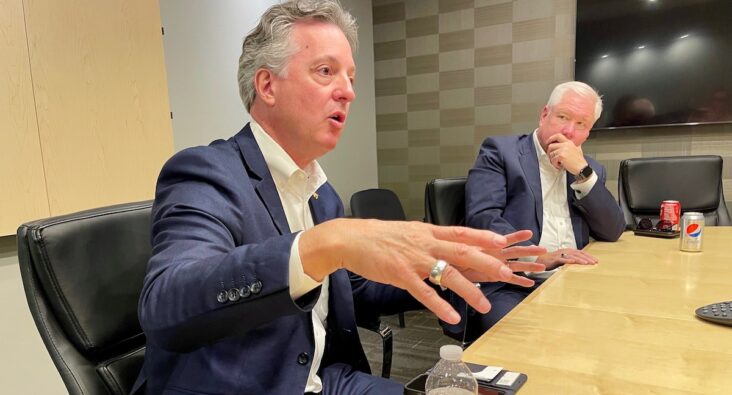
(from left) Fort Smith Regional Chamber of Commerce President and CEO Tim Allen, and Rob Ator, Arkansas Economic Development Commission director of Military Affairs, talk about the effort to bring a foreign pilot training center to Ebbing Air National Guard Base in Fort Smith.
Purposes converged. Rob Ator had been tasked in early 2018 by then-Gov. Asa Hutchinson to retain and recruit military operations. The U.S. Air Force in 2019 needed a new place to train foreign pilots to handle the fifth-generation F-35 fighter plane.
Other things converged, also. There was a quick decision to extend the Fort Smith Regional Airport main runway and a dinner hosted by Alice Walton in her Bentonville art museum. And there was an “air war” over western Arkansas, “damn good” weather when it mattered, and a unique Singapore connection — more on those later.
Ator, a retired Air Force colonel and the Arkansas Economic Development Commission director of Military Affairs, was worried about the future of the 188th Wing located at Ebbing Air National Guard Base in Fort Smith. The wing’s three primary missions are Remotely Piloted Aircraft (MQ-9 Reaper); Intelligence, Surveillance, and Reconnaissance (ISR); and Targeting (Space-Focused). He was in Washington, D.C., to meet with U.S. Sen. Tom Cotton, R-Ark., and other Arkansas Congressional delegation members.
“I said, ‘Hey, look. I’m worried about them (188th). We need to be looking over the horizon for when their mission finally ends. What’s next?” Ator summarized about a meeting with Cotton and his staff in late 2019.
Part of that visit was a meeting with Senate Armed Services Committee staffers to review “different potentials” for a military mission at Ebbing. They mentioned a project in the early stages, but it wasn’t the usual manned mission.
“And what they said to me was, ‘Well, you’re probably not interested in this one because it’s not an operational mission,’” Ator said.
Bingo. Ator, the former commander of the 189th Airlift Wing of the Arkansas Air National Guard, the largest Air National Guard C-130 Wing in the U.S., couldn’t believe his luck.
“Here’s what you have to understand. I ran the C-130 FMS schoolhouse in North Little Rock. So I knew the possibilities because you have different funding streams, and I knew what they would be. I was like, ‘No, no, no. We’d be very interested in this.’ So I put our name in the hopper right then and there,” he explained during a mid-April interview with Talk Business & Politics.
One of Ator’s first stops back in Arkansas was visiting then Arkansas Adjutant General Kendall Penn – now the Arkansas Department of Veterans Affairs secretary – to let him know he wanted to push Ebbing for the FMS site.
“And he was like, ‘Yeah, we’re all in.”
MAKING ‘THE LIST’
There was a time when active duty Air Force bases had the ground and air space for pilot training missions. But as the Air Force began to close and consolidate bases, active duty bases became less accommodating. When the Air Force decided to turn to a guard base to locate the pilot training mission, that opened the door for Arkansas, and Fort Smith, to compete for the rare opportunity to land a new mission at a new base.
Ator said the Singapore military “was quite content” to remain at Luke Air Force Base near Phoenix, Ariz., but the base wasn’t authorized to have more planes, which is what would be needed as more U.S. allies bought the F-35. What was usually a 7- to 8-year process was condensed to less than half that time because the planes were being sold, and the training would be needed well before the normal basing process, Ator said. He admitted to being initially unsure if Arkansas and Fort Smith were “far enough down the path” of being in a position to compete for new military operations.
“I never thought in a million years that I would be landing a new mission. You know how slow the DOD (Department of Defense) operates. This will never happen under my watch, but I’m going to prepare so that we’re ready and in a position to do this,” Ator said.
But then Ebbing made the short list of five bases to be considered for the pilot training center.
“It was when we made the list of five finalists that I knew they were serious about this. And then I said, ‘OK, we can compete because we’re going to outwork everybody.’”
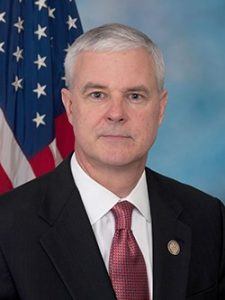
U.S. Rep. Steve Womack, R-Rogers, was not surprised Fort Smith made the shortlist. He was, however, relieved. Ebbing lost its manned mission during his first term in Congress, and he acknowledged “there was a lot of pressure pretty early on” to return a manned mission to Fort Smith.
“When you look at a lot of the requirements for that (pilot training center), Fort Smith really checked a lot of those boxes. … To me, it really came down to two facilities that were serious contenders – Fort Smith and Selfridge (Michigan). But we knew that the available training days, with the weather, the climate, it was going to be pretty much in our favor,” Womack said.
Because of his time with the 189th Airlift Wing, Ator also knew that a training mission had advantages for Arkansas’ Guard presence.
“Training is a great garrison mission for the reserve component. The most experienced operators you have out there belong in the guard and reserve because they are not bouncing around anymore. They train them up one time, they stay there, and they fly for the next 20 years,” he explained.
THE SINGAPOREAN ‘DIRECTION’
Fort Smith Regional Chamber of Commerce President and CEO Tim Allen, also an Arkansas Military Affairs Council member, was brought into the process in early 2020. He and Ator were primarily responsible for coordinating what Allen called “the broad and needed collaboration” to make the best case to the Air Force and Singapore military officials. The Air Force would decide where the base would be, but Singapore had what was essentially a veto if they strongly objected to the Air Force decision.
Then Gov. Asa Hutchinson was worried about the politics of the decision. He joined Arkansas’ Congressional delegation in a meeting with then-U.S. Air Force Secretary Barbara Barrett.
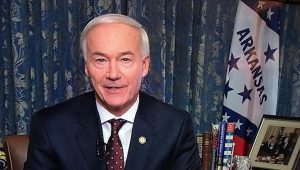
“She immediately said that the Singaporeans are the customers and they are going to have the biggest influence on where this winds up. And that sent a signal that we need to get work on the Singaporeans. That was an important meeting, but also an important direction for us,” Hutchinson said in an April 29 interview.
Allen and Ator began work on a virtual presentation – the COVID-19 pandemic halted on-site visits – that was set for October 2020. In addition to highlighting adjacent military facilities like the Razorback aerial gunnery range, which is just a few minutes by jet from the Fort Smith Regional Airport, joint training facilities at Fort Chaffee for special warfare units, and large military airspace areas in north central Arkansas, they also wanted to sell the region’s intangibles.
“We wanted to showcase Fort Smith and make sure they saw us as a bigger region than just a mid-sized city in the middle of America. So I was definitely promoting a lot of the outdoor activities like the Mulberry (River), the trail systems in Fayetteville and Fort Smith,” Allen said.
FINDING SEPARATION
Following the October 2020 virtual presentation, Allen, Ator and other state and local officials began preparing for a two-day site visit by a delegation of Singapore military and government officials. The Air Force would have liaisons with the delegation.
Allen worked with Fort Smith Mayor George McGill and Fort Smith City Administrator Carl Geffken to roll out the red carpet. Randall Ford donated SUVs, with a Singapore and U.S. flag affixed to each, to convoy the delegation around town. Police Chief Danny Baker provided police escorts.
“But they were unsure about this small town, about Fort Smith. And they had to come see and once they saw the hospitality, you know, we show very well once we get them here. And we did. We just knocked it out of the park. … We wanted them to feel like they all were generals whenever they left here, and we accomplished that,” Allen said.
McGill believes the site visit was crucial in bringing the center to Fort Smith.
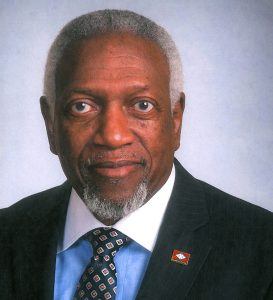
“I think we won when we began to show them our city and introduce them to the people who live here. We showed them our educational facilities and talked about our amenities, our quality of life, and how this would be a safe place for their families. That was particularly important, especially to the Singapore leadership. And we also gave them a tour of all of our great medical facilities,” McGill said. “After that (site visit), they really wanted to be a part of Fort Smith.”
Allen agreed that the tour was important, but they also had to find ways to go above and beyond the typical site visit. Womack said Fort Smith had advantages with the weather, but Selfridge, which had an active manned flight mission, also had advantages.
“We knew it was sort of a coin-flip competition, so you look at ways to separate yourself from the competition,” Womack said.
Allen and Ator said that separation had many elements, but three critical moments during the first Singapore site visit in February put Fort Smith ahead.
THE ‘BRO NETWORK’
Ator wanted to show Singapore military officials the training possible in airspace above western and north central Arkansas. He decided on an “air war,” and, as a former Air Force officer who commanded a large base, he had contacts. He had what he called “the bro network.”
E-3 Sentry “AWACS” from Tinker Air Force Base in Oklahoma City, and KC-135 fuel tankers from McConnell Air Force Base at Wichita, Kan., agreed to be part of the air war simulation. The AWACS bring radar support and integrated command and control to a simulation, and the tankers keep the planes in the air longer. Ator said fighter pilots love having access to AWACS and tankers.
“So you start calling the bros down in Dallas (Navy F-18 fighters), and say, ‘Hey dude, I got tankers, and I got AWACS. We’re gonna create a big air war.’ And so they are all in. And then you call Tulsa (Air Force F-16s) and say, ‘Hey, the F-18 guys from the Navy said they’re coming. What do you think? … We’ll take that.’ So it just grows from that,” Ator said with a grin.
Allen said the delegation visited Razorback Range, a place within Fort Chaffee for aerial gunnery and bombing training. They could see firsthand jets strafing the range and the activity in the air above. Ator said luck was also on their side with “damn good” weather.
“It was February in Arkansas. It was 72 degrees and not a cloud in the fricking sky. You could see the contrails from the air war going on overhead. We took them out to Razorback Range, and they’re dropping bombs and all that stuff,” Ator said.
Allen said it wasn’t lost on the Singapore delegation that Fort Smith was centrally located within a ring of active military bases like Tinker, McConnell, Barksdale (Shreveport, La.), North Little Rock/Jacksonville, Dallas/Fort Worth, and Whiteman (Johnson, Mo.).
“You could see the body language change. They (Singapore delegation) were like, ‘Look at this. Look at all this infrastructure around us.’ They were blown away,” Allen said.
THE RUNWAY
On the first night of the two-day visit in February, Gov. Hutchinson and five cabinet members were in Fort Smith for a dinner and meeting with the Singapore delegation. Before the dinner, the Singapore delegation asked about the length of the Fort Smith main runway – then at 8,417 feet – and wondered if it could be extended. Allen saw the question as more than just a curiosity.
“We want to make sure that it’s clear that the extension of the runway was not a requirement from the Air Force or Singapore. It came up in a conversation with Singapore. ‘Well, we wish you had a little more runway. I mean, we’re training new pilots.’ We knew we had one chance. We had one bite at the apple here. Either we win or lose at the site visit,” Allen said.
The governor would, at the dinner, ask Allen and Ator about the site visit and their thoughts on if Fort Smith had a chance. Allen said they privately told the governor that an issue raised was the runway length. Fortunately, the airport had a recent study about extending the runway by 1,300 feet. The governor had enough information from the study to announce a decision in front of the Singapore delegation.
“I quickly said the state of Arkansas will make sure that runway is lengthened and the runway is not an obstacle,” Hutchinson said.
The city of Fort Smith would later agree to provide $5 million, and the state would kick in $17 million for the extension. That work is expected to be complete by summer.
Hutchinson’s quick commitment to the Singapore delegation to extend the runway “was an example that we could address every concern” raised by the Singapore and Air Force delegations, Ator said. Hutchinson told Talk Business & Politics that supporting the runway extension was an easy decision.
“It’s (pilot training center) probably one of the biggest economic victories the River Valley has ever seen, and the impact will last for decades and decades,” he said.
ALICE AND HER ‘ROCKSTAR’
Rep. Womack said he spent time thinking about “how to add value” to the Singapore site visit that couldn’t be replicated at Selfridge or any other site. He convinced Allen to let part of the two-day visit be a trip to the Rogers-Bentonville area.
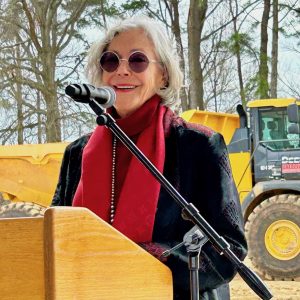
“Despite the fact that the mission is in Fort Smith, you have to consider that Northwest Arkansas is a part of the neighborhood. … So I thought we should get them up there and show them around our neighborhood, so to speak,” Womack said.
Womack said he often reaches out to Alice Walton, Walmart heir and founder of the Bentonville-based Crystal Bridges Museum of American Art, when he knows VIPs will be in the area.
“So I call Alice. She takes my call. And I told her we were about to bring some people from Singapore to the greater Fort Smith area to convince them that that was the site where they needed to do that mission. And her response to me, without hesitation, was, ‘Steve, anything I can do to help Fort Smith, I want to do it,’” Womack said.
He asked her to host them personally at the museum, which she did. Not only was the delegation welcomed by one of the wealthiest people in the world, they were also in a facility designed by acclaimed architect Moshe Safdie. Safdie is a household name in Singapore. He and his firm have designed numerous high-profile projects in Singapore, including the Jewel Changi Airport, Marina Bay Sands Resort, Marina Bay Sands Museum, and the Sky Habitat Residential Development.
“He’s a rockstar in Singapore, and he’s a rockstar in Northwest Arkansas, and frankly we took advantage of the opportunity. We took advantage of her relationship with (Safdie),” Womack said. “I mean, you can’t just pull that off anywhere.”
Ator said that the Air Force liaison pulled him aside when the Singapore delegation was leaving Fort Smith and said the two-day visit changed some minds.
“He said, ‘Dude, you guys were dead. But you guys are going to win this. They can’t stop talking about it. Michigan is going to have to go next level to even be close,” Ator said.
Allen had a similar conversation with one of the Singapore officers.
“He told me they were really just coming here as a courtesy visit but that we had turned their heads. And then we were like, ‘Ok, we have a chance now,’” Allen said.
Womack heard the same from Air Force and Singapore officials.
“We took what I would call an insurmountable lead,” he said.
HEARING, MORATORIUM
Two other actions and events helped put Fort Smith over the top. One was a public hearing in September 2021 that was part of the Air Force’s environmental impact study (EIS). Hundreds of people were at the hearing held at the Fort Smith Convention Center, with the public showing up to support the center.
“Tim Allen and his team and the city, whatever they rolled out in such unanimous testimony before the public hearing, everybody looked at that and said you don’t get that anywhere else. To have that level of support in a community was so instrumental in winning,” Hutchinson said.
Allen said they had a person attend a similar hearing in Selfridge.
“That did not go so well. They didn’t have many people there, and some of those there definitely were not happy about it (pilot training center),” Allen said.
Part of the environmental impact study reviewed noise levels in residential areas. They worried about large residential projects “popping up” around the noise areas that would “cause us a ripple or a slowdown and put us at severe risk,” Ator said.
“It (noise concern) was never brought up by any country. It was us looking at how we could accidentally screw ourselves. And the thought was, ‘We’re going to go into this EIS, and if anything changes in this bubble around Fort Smith, it could cause the EIS to be delayed or to have to start over,’” Allen said.
The Fort Smith Board of Directors would in June 2022 enact a temporary building moratorium in certain areas until Dec. 31, 2023.
NEXT CHALLENGE
The Air Force, on March 10, 2023, signed a record of decision placing the pilot training center at Ebbing. The Singapore delegation supported the decision.
Allen and Ator said the key to success was that everyone involved, including Fort Smith residential developers, were willing to do whatever they could to help. Allen said the work continues to ensure the Air Force has the resources to transform Ebbing into the training center.
“In the past six months, past eight months, every time they (Air Force officials) have actually poked their head up and said, ‘Hey, we’re worried about X,’ we’ve provided a solution. Whether that’s politically or financially, demonstrating what the community will do, what the state will do. An example is the runway extension. From the second that was said, we had this thing on contract two weeks later. Two weeks,” Ator said. “Obviously, this has been a lot of work, but what has made this fun is how everyone jumps in and works collaboratively and stays within their lane and letter of expertise to help where they can.”
Womack said the challenge now is for the community to continue to meet and surpass expectations, especially with the Singapore contingent. He said city officials and residents “will have to be proactive in understanding their culture.” Womack is advocating for a community group to travel to Singapore in the near future to reinforce the idea that Fort Smith will be a welcoming city. He said their desire to be involved in the community is a common topic in visits with Singapore officials.
“The one thing that was consistent in those conversations is that their people will become assimilated and involved in the community where they live. So a lot of that will be on us,” Womack said.
Editor’s note: Lt. Col. Drew “Gus” Nash was selected to “execute basing action processes” required to make the new pilot training center operational. The Air Force declined to make Nash available for this story.
